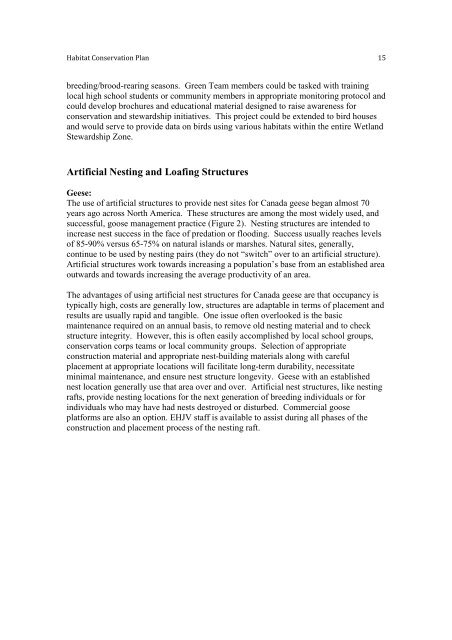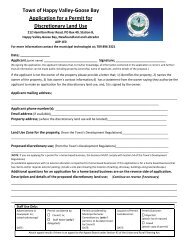Habitat Conservation Plan Habitat Conservation Plan for the Town ...
Habitat Conservation Plan Habitat Conservation Plan for the Town ...
Habitat Conservation Plan Habitat Conservation Plan for the Town ...
- No tags were found...
Create successful ePaper yourself
Turn your PDF publications into a flip-book with our unique Google optimized e-Paper software.
<strong>Habitat</strong> <strong>Conservation</strong> <strong>Plan</strong> 15breeding/brood-rearing seasons. Green Team members could be tasked with traininglocal high school students or community members in appropriate monitoring protocol andcould develop brochures and educational material designed to raise awareness <strong>for</strong>conservation and stewardship initiatives. This project could be extended to bird housesand would serve to provide data on birds using various habitats within <strong>the</strong> entire WetlandStewardship Zone.Artificial Nesting and Loafing StructuresGeese:The use of artificial structures to provide nest sites <strong>for</strong> Canada geese began almost 70years ago across North America. These structures are among <strong>the</strong> most widely used, andsuccessful, goose management practice (Figure 2). Nesting structures are intended toincrease nest success in <strong>the</strong> face of predation or flooding. Success usually reaches levelsof 85-90% versus 65-75% on natural islands or marshes. Natural sites, generally,continue to be used by nesting pairs (<strong>the</strong>y do not “switch” over to an artificial structure).Artificial structures work towards increasing a population’s base from an established areaoutwards and towards increasing <strong>the</strong> average productivity of an area.The advantages of using artificial nest structures <strong>for</strong> Canada geese are that occupancy istypically high, costs are generally low, structures are adaptable in terms of placement andresults are usually rapid and tangible. One issue often overlooked is <strong>the</strong> basicmaintenance required on an annual basis, to remove old nesting material and to checkstructure integrity. However, this is often easily accomplished by local school groups,conservation corps teams or local community groups. Selection of appropriateconstruction material and appropriate nest-building materials along with carefulplacement at appropriate locations will facilitate long-term durability, necessitateminimal maintenance, and ensure nest structure longevity. Geese with an establishednest location generally use that area over and over. Artificial nest structures, like nestingrafts, provide nesting locations <strong>for</strong> <strong>the</strong> next generation of breeding individuals or <strong>for</strong>individuals who may have had nests destroyed or disturbed. Commercial gooseplat<strong>for</strong>ms are also an option. EHJV staff is available to assist during all phases of <strong>the</strong>construction and placement process of <strong>the</strong> nesting raft.






